use of Functions to write python program.pptx
Download as PPTX, PDF0 likes22 views
Functions in python
1 of 12
Download to read offline











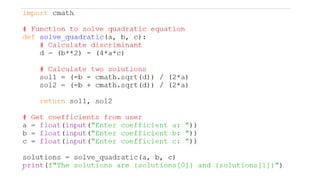
Recommended
04. WORKING WITH FUNCTIONS-2 (1).pptx



04. WORKING WITH FUNCTIONS-2 (1).pptxManas40552
╠²
Functions allow programmers to organize code into reusable units and divide large programs into smaller, more manageable parts. The document discusses key concepts related to functions in Python like defining and calling user-defined functions, passing arguments, scope, and recursion. It provides examples of different types of functions and how concepts like mutability impact parameter passing. Functions are a fundamental part of modular and readable program design.Learn more about the concepts Functions of Python



Learn more about the concepts Functions of PythonPrathamKandari
╠²
Learn more about the concepts Functions of PythonFUNCTIONS IN R PROGRAMMING.pptx



FUNCTIONS IN R PROGRAMMING.pptxSafnaSaff1
╠²
This document discusses functions in R programming. It defines a function as a set of statements organized to perform a specific task. R has many built-in functions as well as user-defined functions. A function in R is created using the 'function' keyword and contains a name, arguments, body, and return value. Built-in functions like seq(), mean(), and max() are directly called, while user-defined functions are specific to what the user wants. Functions are called by supplying valid arguments and can have default values. Arguments are evaluated lazily. Recursive functions call themselves and are used for techniques like dynamic programming.All chapters C++ - Copy.pdfyttttttttttttttttttttttttttttt



All chapters C++ - Copy.pdfytttttttttttttttttttttttttttttjacobdiriba
╠²
yesmmmmmmmmmmmmmmmmmmmmmmmmmmmmmmmmmmmmmmmmmmmmmmmmmmmmmmmmmmmmmmmmmmmmmmmmmmmmmmmmmmmmmmmmmmmmmmmmmmmmmmmmmmmmmmmmmmmmmmmmmmmmmmmmmmmmmmmmmmmmmmmmmmmmmmmmmmmmmmmmmmmmmmmmmmmmmmmmmmmmmmmmmmmmmmmmmmmmmmmmmmmmmmmmmmmmmmmmmmmmmmmmmmmmmmmmmmmmmmmmmmmmmmmmmmmmmmmmmmmmmmmmmmmmmmmmmmmmmmmmmmmmmmmmmmmmmmmmmmmmmmmmmmmmmmmmmmmmmmmmmmmmmmmmmmmmmmmmmmmmmmmmmmmmmmmmmmmmmmmmmmmmmmmmmmmmmmmmmmmmmmmmmmmmmmmmmmmmmmmmmmmmmmmmmmmmmmmmmmmmmmmmmmmmmmmmmmmmmmmmmmmmmmmmmmmmmmmmmmmmmmmmmmmmmmmmmmmmmmmmmmmmmmmmmmmmmmmmmmmmmmmmmmmmmmmmmmmmmmmmmmmmmmmmmmmmmmmmmmmmmmmmmmmmmmmmmmmmmmmmmmmmmmmmmmmmmmmmmmmmmmmmmmmmmmmmmmmmmmmmmmmmmmmmmmmmmmmmmmmmmmmmmmmmmmmmmmmmmmmmmmmmmmmmmmmmmmmmmmmmmmmmmmmmmmmmmmmmmmmmmmmmmmmmmmmmmmmmmmklllllllllllllllllllllllllllllllllllllllllllllllllllllllllllllllllllllllllllllllllllllllllllllllllllllllllllllllllljjjjjjjjjjjjjjjjjjjjjjjjjjjjjjjjjjjjjjjjjjjjjjjjjjjjjjjjjjjjjjjjjjjjjjjjjjjjjjjjjjjjjjjjjjjjjjjjjjjjjjjjjjjjjjjjjjjjjjjjjjjjjjjjjjjjjjjjjjjjjjjjjjjjjjjjjjjjjjjjjjjjjjjjjjjjjjjjjjjjjjjjyesmmmmmmmmmmmmmmmmmmmmmmmmmmmmmmmmmmmmmmmmmmmmmmmmmmmmmmmmmmmmmmmmmmmmmmmmmmmmmmmmmmmmmmmmmmmmmmmmmmmmmmmmmmmmmmmmmmmmmmmmmmmmmmmmmmmmmmmmmmmmmmmmmmmmmmmmmmmmmmmmmmmmmmmmmmmmmmmmmmmmmmmmmmmmmmmmmmmmmmmmmmmmmmmmmmmmmmmmmmmmmmmmmmmmmmmmmmmmmmmmmmmmmmmmmmmmmmmmmmmmmmmmmmmmmmmmmmmmmmmmmmmmmmmmmmmmmmmmmmmmmmmmmmmmmmmmmmmmmmmmmmmmmmmmmmmmmmmmmmmmmmmmmmmmmmmmmmmmmmmmmmmmmmmmmmmmmmmmmmmmmmmmmmmmmmmmmmmmmmmmmmmmmmmmmmmmmmmmmmmmmmmmmmmmmmmmmmmmmmmmmmmmmmmmmmmmmmmmmmmmmmmmmmmmmmmmmmmmmmmmmmmmmmmmmmmmmmmmmmmmmmmmmmmmmmmmmmmmmmmmmmmmmmmmmmmmmmmmmmmmmmmmmmmmmmmmmmmmmmmmmmmmmmmmmmmmmmmmmmmmmmmmmmmmmmmmmmmmmmmmmmmmmmmmmmmmmmmmmmmmmmmmmmmmmmmmmmmmmmmmmmmmmmmmmmmmmmmmmmmmmmmmmmmmmmmmmmmmmmmmmmmmmmmmmmmmmmmmmmklllllllllllllllllllllllllllllllllllllllllllllllllllllllllllllllllllllllllllllllllllllllllllllllllllllllllllllllllljjjjjjjjjjjjjjjjjjjjjjjjjjjjjjjjjjjjjjjjjjjjjjjjjjjjjjjjjjjjjjjjjjjjjjjjjjjjjjjjjjjjjjjjjjjjjjjjjjjjjjjjjjjjjjjjjjjjjjjjjjjjjjjjjjjjjjjjjjjjjjjjjjjjjjjjjjjjjjjjjjjjjjjjjjjjjjjjjjjjjjjjyesmmmmmmmmmmmmmmmmmmmmmmmmmmmmmmmmmmmmmmmmmmmmmmmmmmmmmmmmmmmmmmmmmmmmmmmmmmmmmmmmmmmmmmmmmmmmmmmmmmmmmmmmmmmmmmmmmmmmmmmmmmmmmmmmmmmmmmmmmmmmmmmmmmmmmmmmmmmmmmmmmmmmmmmmmmmmmmmmmmmmmmmmmmmmmmmmmmmmmmmmmmmmmmmmmmmmmmmmmmmmmmmmmmmmmmmmmmmmmmmmmmmmmmmmmmmmmmmmmmmmmmmmmmmmmmmmmmmmmmmmmmmmmmmmmmmmmmmmmmmmmmmmmmmmmmmmmmmmmmmmmmmmmmmmmmmmmmmmmmmmmmmmmmmmmmmmmmmmmmmmmmmmmmmmmmmmmmmmmmmmmmmmmmmmmmmmmmmmmmmmmmmmmmmmmmmmmmmmmmmmmmmmmmmmmmmmmmmmmmmmmmmmmmmmmmmmmmmmmmmmmmmmmmmmmmmmmmmmmmmmmmmmmmmmmmmmmmmmmmmmmmmmmmmmmmmmmmmmmmmmmmmmmmmmmmmmmmmmmmmmmmmmmmmmmmmmmmmmmmmmmmmmmmmmmmmmmmmmmmmmmmmmmmmmmmmmmmmmmmmmmmmmmmmmmmmmmmmmmmmmmmmmmmmmmmmmmmmmmmmmmmmmmmmmmmmmmmmmmmmmmmmmmmmmmmmmmmmmmmmmmmmmmmmmmmmmmmmmmmklllllllllllllllllllllllllllllllllllllllllllllllllllllllllllllllllllllllllllllllllllllllllllllllllllllllllllllllllljjjjjjjjjjjjjjjjjjjjjjjjjjjjjjjjjjjjjjjjjjjjjjjjjjjjjjjjjjjjjjjjjjjjjjjjjjjjjjjjjjjjjjjjjjjjjjjjjjjjjjjjjjjjjjjjjjjjjjjjjjjjjjjjjjjjjjjjjjjjjjjjjjjjjjjjjjjjjjjjjjjjjjjjjjjjjjjjjjjjjjjFUNCTION CPU



FUNCTION CPUKrushal Kakadia
╠²
This document discusses functions in C programming. It defines functions as a group of statements that perform a specific task and have a name. Main functions must be included in every C program as it is where program execution begins. Functions help facilitate modular programming by dividing programs into smaller parts. Functions can be user-defined or built-in library functions. Parameters can be passed to functions by value or by reference. Functions can call themselves through recursion. Variables have different storage classes like auto, register, static, and external that determine scope and lifetime.Chapter 11 Function



Chapter 11 FunctionDeepak Singh
╠²
Functions allow programmers to organize code into reusable blocks. A function performs a specific task and can accept input parameters and return an output. Functions make code more modular and easier to maintain. Functions are defined with a name, parameters, and body. They can be called from other parts of the code to execute their task. Parameters allow functions to accept input values, while return values allow functions to return output to the calling code. Functions can be called by passing arguments by value or reference. The document provides examples and explanations of different types of functions in C++ like inline functions, functions with default arguments, and global vs local variables.3-Python Functions.pdf in simple.........



3-Python Functions.pdf in simple.........mxdsnaps
╠²
Very easy presentation for studying at last moment ¤śģPowerpoint presentation for Python Functions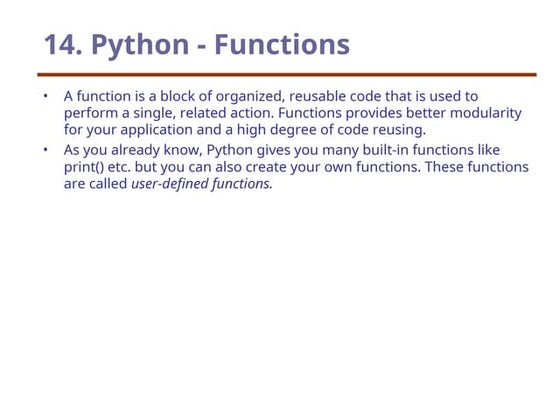



Powerpoint presentation for Python FunctionsBalaSubramanian376976
╠²
Python Functions Descriptions PPTFunctions in C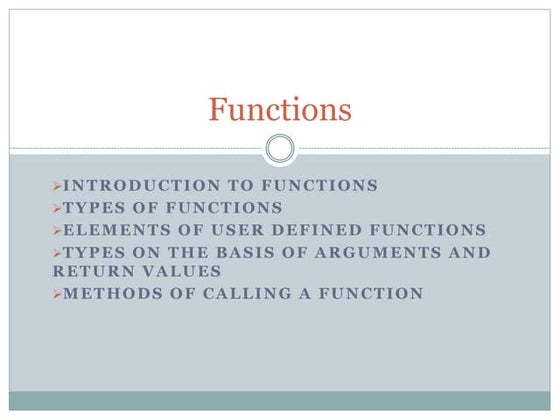



Functions in CKamal Acharya
╠²
This document discusses different types of functions in C programming. It defines library functions, user-defined functions, and the key elements of functions like prototypes, arguments, parameters, return values. It categorizes functions based on whether they have arguments and return values. The document also explains how functions are called, either by value where changes are not reflected back or by reference where the original values are changed.function of C.pptx



function of C.pptxshivas379526
╠²
This document discusses different types of functions in C programming. It introduces library functions, user-defined functions, and the key elements of functions like function prototypes, arguments, parameters, return values, and function definitions. It also categorizes functions based on whether they have arguments and return values. Finally, it covers the different ways functions can be called, either by passing values or by passing references.functions new.pptx



functions new.pptxbhuvanalakshmik2
╠²
The document discusses functions in Python. It introduces functions as a way to divide large programs into smaller, more manageable units called functions. Functions allow code to be reused by calling or invoking the function from different parts of a program. The document then covers key concepts related to functions like arguments, parameters, scope, recursion, and more. It provides examples to illustrate different types of functions and how concepts like scope, recursion, and argument passing work.4. function



4. functionShankar Gangaju
╠²
Functions are self-contained blocks of code that perform specific tasks. There are library functions provided by the C standard and user-defined functions created by programmers. Functions make programs clearer and easier to debug by separating code into logical units. Functions can call themselves recursively to perform repetitive tasks. Functions are defined with a return type, name, and parameters, and code is passed between functions using call-by-value parameter passing. Function prototypes declare functions before they are used.Chapter 1. Functions in C++.pdf



Chapter 1. Functions in C++.pdfTeshaleSiyum
╠²
The document provides an overview of functions in C++. It discusses the basic concepts of functions including declaring, defining, and calling functions. It covers function components like parameters and arguments. It explains passing parameters by value and reference. It also discusses different types of functions like built-in functions, user-defined functions, and functions with default arguments. Additionally, it covers concepts like scope of variables, return statement, recursion, and automatic vs static variables. The document is intended to teach the fundamentals of functions as building blocks of C++ programs.Chapter_1.__Functions_in_C++[1].pdf![Chapter_1.__Functions_in_C++[1].pdf](https://cdn.slidesharecdn.com/ss_thumbnails/chapter1-230901115452-13a8ca1c-thumbnail.jpg?width=560&fit=bounds)
![Chapter_1.__Functions_in_C++[1].pdf](https://cdn.slidesharecdn.com/ss_thumbnails/chapter1-230901115452-13a8ca1c-thumbnail.jpg?width=560&fit=bounds)
![Chapter_1.__Functions_in_C++[1].pdf](https://cdn.slidesharecdn.com/ss_thumbnails/chapter1-230901115452-13a8ca1c-thumbnail.jpg?width=560&fit=bounds)
![Chapter_1.__Functions_in_C++[1].pdf](https://cdn.slidesharecdn.com/ss_thumbnails/chapter1-230901115452-13a8ca1c-thumbnail.jpg?width=560&fit=bounds)
Chapter_1.__Functions_in_C++[1].pdfTeshaleSiyum
╠²
The document provides an overview of functions in C++. It discusses the basic concepts of functions including declaring, defining, and calling functions. It covers different types of functions such as built-in functions, user-defined functions, and functions that return values. The key components of a function like the prototype, definition, parameters, arguments, and return statement are explained. It also describes different ways of passing parameters to functions, including call by value and call by reference. Functions allow breaking down programs into smaller, reusable components, making the code more readable, maintainable and reducing errors.Lecture 11 - Functions



Lecture 11 - FunctionsMd. Imran Hossain Showrov
╠²
C Programming Language is the most popular computer language and most used programming language till now. It is very simple and elegant language. This lecture series will give you basic concepts of structured programming language with C. Python functions



Python functionsProf. Dr. K. Adisesha
╠²
Functions allow programmers to organize code into reusable blocks. A function is defined using the def keyword and can accept parameters. The body of a function contains a set of statements that run when the function is called. Functions can return values and allow code to be reused, reducing errors and improving readability. Parameters allow information to be passed into functions, while return values allow functions to provide results.Functions and modular programming.pptx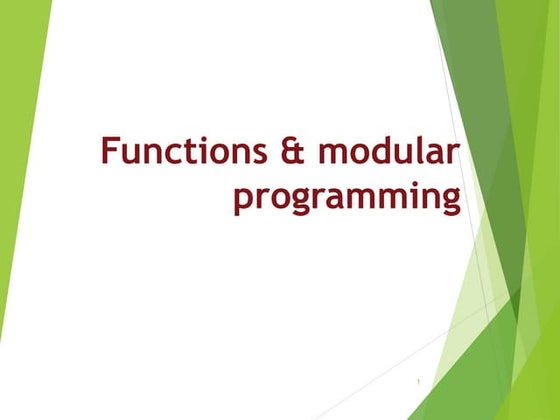



Functions and modular programming.pptxzueZ3
╠²
This document discusses functions and modular programming in C++. It defines what a function is and explains that functions allow dividing code into separate and reusable tasks. It covers function declarations, definitions, parameters, return types, and calling functions. It also discusses different ways of passing arguments to functions: call by value, call by pointer, and call by reference. Finally, it provides an example program that calculates addition and subtraction using different functions called within the main function. Modular programming is also summarized as dividing a program into independent and reusable modules to reduce complexity, decrease duplication, improve collaboration and testing.Functions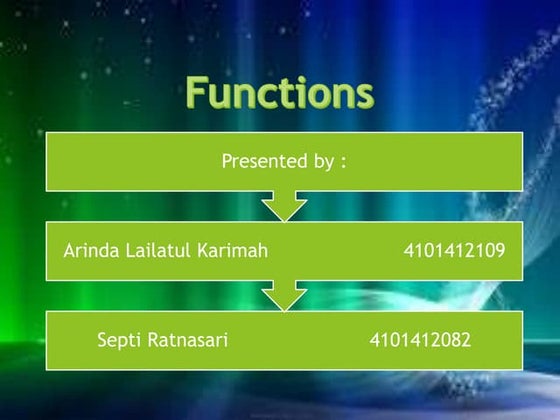



FunctionsSepti Ratnasari
╠²
The document describes functions in Pascal programming. It defines what a function is, how it is similar to and different from procedures. It explains the parts of a function like arguments, return type, local declarations, and function body. It provides examples of a basic max function and how to declare, define, call and recursively call functions. It discusses acceptable return types and notes about short-circuit evaluation and passing functions as parameters.User defined function in C.pptx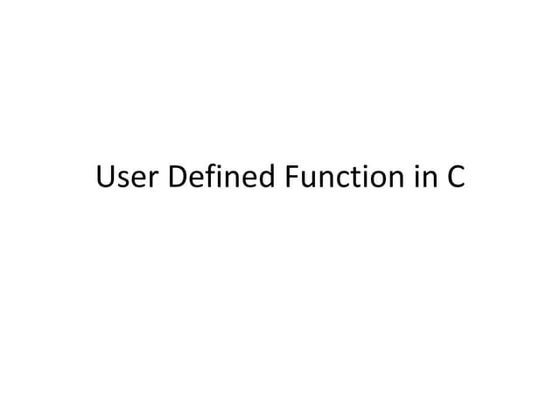



User defined function in C.pptxRhishav Poudyal
╠²
User Defined Function in C
- Functions modularize programs and allow for code reusability. Parameters allow communication between functions.
- A function definition includes a return type, name, parameters, and block of statements. Functions are called within other functions.
- Functions provide benefits like divide and conquer programming, manageable development, and abstraction that hides internal details.Function



FunctionGauravGautam224100
╠²
Functions allow for code reusability and modularization. A function is defined using the def keyword followed by the function name and parameters. Functions can take in arguments as inputs and return a value. Variables declared inside a function have local scope while those outside have global scope. Default parameter values can be specified in the function definition.Ch4 functions



Ch4 functionsHattori Sidek
╠²
The document introduces functions in C programming. It discusses defining and calling library functions and user-defined functions, passing arguments to functions, returning values from functions, and writing recursive functions. Functions allow breaking programs into modular and reusable units of code. Library functions perform common tasks like input/output and math operations. User-defined functions are created to perform specific tasks. Information is passed between functions via arguments and return values.VIT351 Software Development VI Unit1



VIT351 Software Development VI Unit1YOGESH SINGH
╠²
COURSE TITLE: SOFTWARE DEVELOPMENT VI
COURSE CODE: VIT 351
TOPICS COVERED:
C STANDARD LIBRARIES
FUNCTIONS IN C
RECURSION
QUIZ SETfunctions.pptx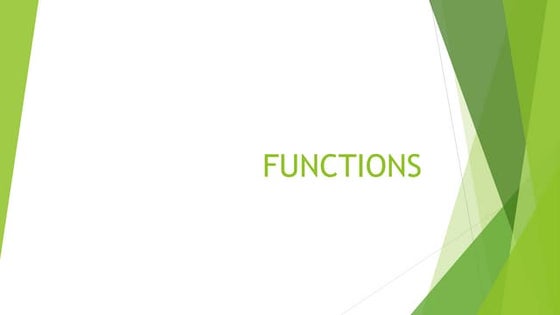



functions.pptxKavithaChekuri3
╠²
The document defines and explains different types of functions in Python. It discusses defining functions, calling functions, passing arguments by reference versus value, writing functions using different approaches like anonymous functions and recursive functions. Some key points covered include: defining a function uses the def keyword followed by the function name and parameters; functions can be called by their name with arguments; arguments are passed by reference for mutable objects and by value for immutable objects; anonymous functions are defined using the lambda keyword and return a single expression; recursive functions call themselves to break down problems into sub-problems until a base case is reached.Chapter One Function.pptx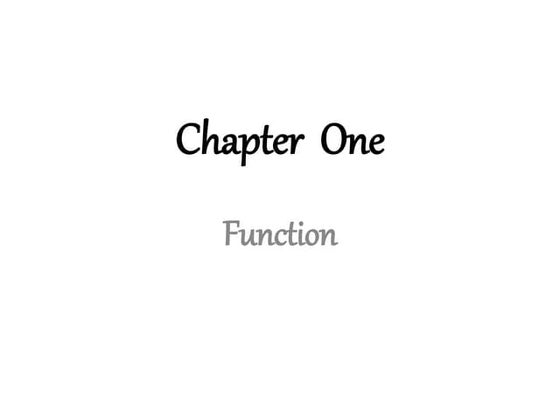



Chapter One Function.pptxmiki304759
╠²
This document provides an overview of functions in C++. It defines what a function is, how to declare and define functions, how to call functions, and the differences between passing arguments by value versus by reference. A function is a block of code that performs a specific task. Functions are declared with a return type and parameter list, and defined with a body of code. Arguments can be passed into functions either by value, where the function receives a copy of the argument, or by reference, where any changes to the argument are reflected in the original variable. Well-designed programs use modular functions to organize code into reusable components.C functions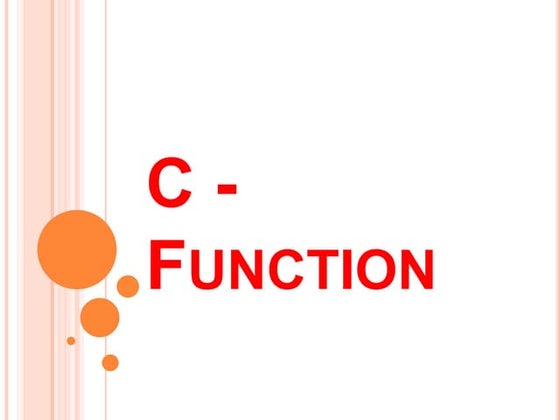



C functionsUniversity of Potsdam
╠²
A function is a group of statements that together perform a task. Every C program has at least one function, which is main(), and all the most trivial programs can define additional functions. You can divide up your code into separate functions.Java script function



Java script functionsuresh raj sharma
╠²
Functions are JavaScript procedures that perform tasks and can be defined using the function keyword. Functions can have parameters and a body of statements. Functions allow for nested scopes where bindings inside functions are local while bindings outside any function are global. Function values can be passed as arguments, stored in bindings, and used similarly to other values. The call stack stores the context each time a function is called and removes it when the function returns.Jotform AI Agents: Overview and Benefits



Jotform AI Agents: Overview and BenefitsJotform
╠²
Imagine a world where you can respond instantly to any customer, anytime, anywhere.
Improve user satisfaction on every channel. With Jotform AI Agents, you can streamline your customer service processes. Easily train your agent with your company data, identify the common questions you receive and your answers. Let your agent handle the rest.
Learn more about the benefits of Jotform AI Agents with this slide. For more information, visit https://www.jotform.com/ai/agents/Autodesk MotionBuilder 2026 Free Download



Autodesk MotionBuilder 2026 Free Downloadblouch52kp
╠²
¤īŹ¤ō▒¤æēCOPY LINK & PASTE ON GOOGLE https://9to5mac.org/after-verification-click-go-to-download-page¤æł¤īŹ
Free download Autodesk MotionBuilder for Windows. It is 3D character animation software for virtual production that helps you manipulate and refine data with excellent reliability and efficiency. Capture, edit, and playback complex character animation in a highly responsive, interactive environment and work with a display optimized for both animators and directors.
More Related Content
Similar to use of Functions to write python program.pptx (20)
Powerpoint presentation for Python Functions



Powerpoint presentation for Python FunctionsBalaSubramanian376976
╠²
Python Functions Descriptions PPTFunctions in C



Functions in CKamal Acharya
╠²
This document discusses different types of functions in C programming. It defines library functions, user-defined functions, and the key elements of functions like prototypes, arguments, parameters, return values. It categorizes functions based on whether they have arguments and return values. The document also explains how functions are called, either by value where changes are not reflected back or by reference where the original values are changed.function of C.pptx



function of C.pptxshivas379526
╠²
This document discusses different types of functions in C programming. It introduces library functions, user-defined functions, and the key elements of functions like function prototypes, arguments, parameters, return values, and function definitions. It also categorizes functions based on whether they have arguments and return values. Finally, it covers the different ways functions can be called, either by passing values or by passing references.functions new.pptx



functions new.pptxbhuvanalakshmik2
╠²
The document discusses functions in Python. It introduces functions as a way to divide large programs into smaller, more manageable units called functions. Functions allow code to be reused by calling or invoking the function from different parts of a program. The document then covers key concepts related to functions like arguments, parameters, scope, recursion, and more. It provides examples to illustrate different types of functions and how concepts like scope, recursion, and argument passing work.4. function



4. functionShankar Gangaju
╠²
Functions are self-contained blocks of code that perform specific tasks. There are library functions provided by the C standard and user-defined functions created by programmers. Functions make programs clearer and easier to debug by separating code into logical units. Functions can call themselves recursively to perform repetitive tasks. Functions are defined with a return type, name, and parameters, and code is passed between functions using call-by-value parameter passing. Function prototypes declare functions before they are used.Chapter 1. Functions in C++.pdf



Chapter 1. Functions in C++.pdfTeshaleSiyum
╠²
The document provides an overview of functions in C++. It discusses the basic concepts of functions including declaring, defining, and calling functions. It covers function components like parameters and arguments. It explains passing parameters by value and reference. It also discusses different types of functions like built-in functions, user-defined functions, and functions with default arguments. Additionally, it covers concepts like scope of variables, return statement, recursion, and automatic vs static variables. The document is intended to teach the fundamentals of functions as building blocks of C++ programs.Chapter_1.__Functions_in_C++[1].pdf![Chapter_1.__Functions_in_C++[1].pdf](https://cdn.slidesharecdn.com/ss_thumbnails/chapter1-230901115452-13a8ca1c-thumbnail.jpg?width=560&fit=bounds)
![Chapter_1.__Functions_in_C++[1].pdf](https://cdn.slidesharecdn.com/ss_thumbnails/chapter1-230901115452-13a8ca1c-thumbnail.jpg?width=560&fit=bounds)
![Chapter_1.__Functions_in_C++[1].pdf](https://cdn.slidesharecdn.com/ss_thumbnails/chapter1-230901115452-13a8ca1c-thumbnail.jpg?width=560&fit=bounds)
![Chapter_1.__Functions_in_C++[1].pdf](https://cdn.slidesharecdn.com/ss_thumbnails/chapter1-230901115452-13a8ca1c-thumbnail.jpg?width=560&fit=bounds)
Chapter_1.__Functions_in_C++[1].pdfTeshaleSiyum
╠²
The document provides an overview of functions in C++. It discusses the basic concepts of functions including declaring, defining, and calling functions. It covers different types of functions such as built-in functions, user-defined functions, and functions that return values. The key components of a function like the prototype, definition, parameters, arguments, and return statement are explained. It also describes different ways of passing parameters to functions, including call by value and call by reference. Functions allow breaking down programs into smaller, reusable components, making the code more readable, maintainable and reducing errors.Lecture 11 - Functions



Lecture 11 - FunctionsMd. Imran Hossain Showrov
╠²
C Programming Language is the most popular computer language and most used programming language till now. It is very simple and elegant language. This lecture series will give you basic concepts of structured programming language with C. Python functions



Python functionsProf. Dr. K. Adisesha
╠²
Functions allow programmers to organize code into reusable blocks. A function is defined using the def keyword and can accept parameters. The body of a function contains a set of statements that run when the function is called. Functions can return values and allow code to be reused, reducing errors and improving readability. Parameters allow information to be passed into functions, while return values allow functions to provide results.Functions and modular programming.pptx



Functions and modular programming.pptxzueZ3
╠²
This document discusses functions and modular programming in C++. It defines what a function is and explains that functions allow dividing code into separate and reusable tasks. It covers function declarations, definitions, parameters, return types, and calling functions. It also discusses different ways of passing arguments to functions: call by value, call by pointer, and call by reference. Finally, it provides an example program that calculates addition and subtraction using different functions called within the main function. Modular programming is also summarized as dividing a program into independent and reusable modules to reduce complexity, decrease duplication, improve collaboration and testing.Functions



FunctionsSepti Ratnasari
╠²
The document describes functions in Pascal programming. It defines what a function is, how it is similar to and different from procedures. It explains the parts of a function like arguments, return type, local declarations, and function body. It provides examples of a basic max function and how to declare, define, call and recursively call functions. It discusses acceptable return types and notes about short-circuit evaluation and passing functions as parameters.User defined function in C.pptx



User defined function in C.pptxRhishav Poudyal
╠²
User Defined Function in C
- Functions modularize programs and allow for code reusability. Parameters allow communication between functions.
- A function definition includes a return type, name, parameters, and block of statements. Functions are called within other functions.
- Functions provide benefits like divide and conquer programming, manageable development, and abstraction that hides internal details.Function



FunctionGauravGautam224100
╠²
Functions allow for code reusability and modularization. A function is defined using the def keyword followed by the function name and parameters. Functions can take in arguments as inputs and return a value. Variables declared inside a function have local scope while those outside have global scope. Default parameter values can be specified in the function definition.Ch4 functions



Ch4 functionsHattori Sidek
╠²
The document introduces functions in C programming. It discusses defining and calling library functions and user-defined functions, passing arguments to functions, returning values from functions, and writing recursive functions. Functions allow breaking programs into modular and reusable units of code. Library functions perform common tasks like input/output and math operations. User-defined functions are created to perform specific tasks. Information is passed between functions via arguments and return values.VIT351 Software Development VI Unit1



VIT351 Software Development VI Unit1YOGESH SINGH
╠²
COURSE TITLE: SOFTWARE DEVELOPMENT VI
COURSE CODE: VIT 351
TOPICS COVERED:
C STANDARD LIBRARIES
FUNCTIONS IN C
RECURSION
QUIZ SETfunctions.pptx



functions.pptxKavithaChekuri3
╠²
The document defines and explains different types of functions in Python. It discusses defining functions, calling functions, passing arguments by reference versus value, writing functions using different approaches like anonymous functions and recursive functions. Some key points covered include: defining a function uses the def keyword followed by the function name and parameters; functions can be called by their name with arguments; arguments are passed by reference for mutable objects and by value for immutable objects; anonymous functions are defined using the lambda keyword and return a single expression; recursive functions call themselves to break down problems into sub-problems until a base case is reached.Chapter One Function.pptx



Chapter One Function.pptxmiki304759
╠²
This document provides an overview of functions in C++. It defines what a function is, how to declare and define functions, how to call functions, and the differences between passing arguments by value versus by reference. A function is a block of code that performs a specific task. Functions are declared with a return type and parameter list, and defined with a body of code. Arguments can be passed into functions either by value, where the function receives a copy of the argument, or by reference, where any changes to the argument are reflected in the original variable. Well-designed programs use modular functions to organize code into reusable components.C functions



C functionsUniversity of Potsdam
╠²
A function is a group of statements that together perform a task. Every C program has at least one function, which is main(), and all the most trivial programs can define additional functions. You can divide up your code into separate functions.Java script function



Java script functionsuresh raj sharma
╠²
Functions are JavaScript procedures that perform tasks and can be defined using the function keyword. Functions can have parameters and a body of statements. Functions allow for nested scopes where bindings inside functions are local while bindings outside any function are global. Function values can be passed as arguments, stored in bindings, and used similarly to other values. The call stack stores the context each time a function is called and removes it when the function returns.Recently uploaded (20)
Jotform AI Agents: Overview and Benefits



Jotform AI Agents: Overview and BenefitsJotform
╠²
Imagine a world where you can respond instantly to any customer, anytime, anywhere.
Improve user satisfaction on every channel. With Jotform AI Agents, you can streamline your customer service processes. Easily train your agent with your company data, identify the common questions you receive and your answers. Let your agent handle the rest.
Learn more about the benefits of Jotform AI Agents with this slide. For more information, visit https://www.jotform.com/ai/agents/Autodesk MotionBuilder 2026 Free Download



Autodesk MotionBuilder 2026 Free Downloadblouch52kp
╠²
¤īŹ¤ō▒¤æēCOPY LINK & PASTE ON GOOGLE https://9to5mac.org/after-verification-click-go-to-download-page¤æł¤īŹ
Free download Autodesk MotionBuilder for Windows. It is 3D character animation software for virtual production that helps you manipulate and refine data with excellent reliability and efficiency. Capture, edit, and playback complex character animation in a highly responsive, interactive environment and work with a display optimized for both animators and directors.
Threat Modeling & Risk Assessment Webinar: A Step-by-Step Example



Threat Modeling & Risk Assessment Webinar: A Step-by-Step ExampleICS
╠²
Threat modeling and performing a risk assessment are required by the FDA as part of a 510(k) pre-market submission and will tell you what cybersecurity is needed to make sure your medical device is secure. Webinar presenters will go step-by-step through a threat model and risk assessment for a number of attack paths to clearly show how it is done. By the end of the webinar you will have a very good idea of how to develop a cybersecurity threat model and to perform risk analysis. Software Architecture and Design-Ch-1.v6



Software Architecture and Design-Ch-1.v6Salahaddin University-Erbil, University of Kurdistan Hewler
╠²
Software Architecture and Design, School of Computer Science and Engineering, University of Kurdistan Hewler.REVIEW AI Apps Empire The Future of No-Code Ai Apps is Here!



REVIEW AI Apps Empire The Future of No-Code Ai Apps is Here!stanislausGabriel
╠²
No Coding, No Hiring, No Hassle
Create AI Apps Like Never BeforeŌĆö Fast, Profitable, and 100% No-Code
Now Discover What Makes AI Apps Empire the Ultimate No-Code Ai Game-Changer!
Instantly Create, Customize & Launch Your Dream AI App for Any Purpose
Turn any idea into an AI-powered app with just a few clicks. Build high-demand apps that businesses & marketers are ready to pay for!
Review
AI Apps Empire is a no-code platform designed to enable users to create, customize, and sell AI-powered applications without any coding expertise. Launched on April 4, 2025, by Bizomart on the WarriorPlus marketplace, this platform offers over 250 ready-to-launch AI apps across various niches, including marketing, e-commerce, and local business solutions.
Key Features:
ŌĆó No-Code AI App Builder: Allows users to build fully white-labeled AI apps in approximately 60 seconds without any coding skills.
ŌĆó
ŌĆó Extensive App Library: Provides access to over 250 pre-made AI applications catering to diverse industries.
ŌĆó Customization and Branding: Users can personalize apps with their own branding elements, including logos and domain names, ensuring a unique market presence.
ŌĆó
ŌĆó Monetization Support: Integrates with payment gateways like Stripe and PayPal, facilitating the sale of apps through one-time purchases or subscription models.
ŌĆó
ŌĆó Commercial License Included: Enables users to sell unlimited AI apps to clients and retain 100% of the profits.
ŌĆó
Pros:
ŌĆó User-Friendly Interface: Designed for entrepreneurs and small business owners without technical backgrounds, making AI app development accessible.
ŌĆó
ŌĆó Comprehensive Business Package: Offers a complete suite, including done-for-you SaaS websites, marketing materials, and client management tools, streamlining the process of launching an AI SaaS business.
ŌĆó
ŌĆó Global Reach: Supports app creation in multiple languages, allowing users to cater to a worldwide audience.
Cons:
ŌĆó Internet Dependency: Requires a stable internet connection for optimal performance.
ŌĆó Potential Learning Curve: Despite its user-friendly design, newcomers might need time to fully explore and utilize all features effectively.
Pricing:
AI Apps Empire is available starting at a one-time fee of $32.53, with additional upsells and packages offered to expand functionality and access.
Conclusion:
AI Apps Empire presents a robust solution for individuals and businesses aiming to enter the AI application market without the complexities of coding. Its extensive library of customizable apps, combined with monetization tools and a commercial license, positions it as a valuable asset for those looking to establish or expand their presence in the AI-driven software industry.
The Open-Closed Principle - Part 2 - The Contemporary Version - An Introduction



The Open-Closed Principle - Part 2 - The Contemporary Version - An IntroductionPhilip Schwarz
╠²
The Open-Closed Principle - Part 2 - The Contemporary Version - An IntroductionTop Performance Testing Tools of 2025: Ensure Speed, Stability, and Scale



Top Performance Testing Tools of 2025: Ensure Speed, Stability, and ScaleShubham Joshi
╠²
In 2025, speed and scalability are critical for delivering exceptional user experiences. This guide highlights the best performance testing tools available this yearŌĆöeach offering powerful features like real-time monitoring, cloud-based load simulation, and integration with CI/CD pipelines. Whether you're testing web, mobile, or enterprise apps, these tools ensure your product performs under pressure.RocketVideos AI ŌĆō The Ultimate AI Video Creation Tool



RocketVideos AI ŌĆō The Ultimate AI Video Creation ToolRichmaven
╠²
Welcome to the complete walkthrough of RocketVideosAi, the cutting-edge, AI-powered tool that's transforming the way creators, marketers, and businesses produce high-quality videosŌĆöwithout the hassle of manual editing or expensive software.
In this ║▌║▌▀ŻShare, weŌĆÖll dive deep into how RocketVideosAi helps you turn simple ideas into cinematic, scroll-stopping videos in just minutes. Whether you're a content creator, educator, advertiser, or entrepreneur, RocketVideosAi is designed to simplify your workflow and supercharge your content strategy!
¤öŹ What YouŌĆÖll Learn in This Presentation:
Ō£ģ What is RocketVideosAi and how does it work
Ō£ģ Key features including AI storyboard, voiceovers, character animation & more
Ō£ģ How to create videos in 3 easy steps
Ō£ģ Who should use RocketVideosAi and why
Ō£ģ Complete pricing breakdown & OTOs (One-Time Offers)
Ō£ģ Bonuses worth over $50,000
Ō£ģ Pros, cons, and final verdict
¤ÆĪ Why RocketVideosAi?
Gone are the days of complicated software and hours of video editing. With RocketVideosAi, all you need is a script or prompt. The AI takes care of storyboarding, character generation, realistic voiceovers, animations, captions, and moreŌĆögiving you studio-quality videos in minutes.
¤Äü Exclusive Bonuses Include:
¤Ä» Rocket QR URL Shortener
¤Ä» Rocket Bio Pages
¤Ä» Rocket Academy Course Builder
¤Ä» Rocket Proof Notification Widget
¤Ä» + $50,000+ Worth of Premium Bonuses Only Through Our Link!
¤Æź Perfect For:
¤ō╣ YouTubers & Influencers
¤ōł Marketers & Ecommerce Sellers
¤ōÜ Educators & Online Coaches
¤Åó Small Businesses & Agencies
¤¦Ā Anyone who wants to create videos without the learning curve!
¤ÆĖ Launch Offer: One-Time Price ŌĆō Only $39!
¤öź Use Discount Coupon: ROCKET5 for $5 OFF
¤ĢÆ Limited-Time Launch ŌĆō DonŌĆÖt Miss Out!
¤æē Visit the official RocketVideosAi site to grab your access and get all launch bonuses before the timer runs out!Image-Line FL Studio 20.8.3.2304 crack free



Image-Line FL Studio 20.8.3.2304 crack freealihamzakpa084
╠²
¤īŹ¤ō▒¤æēCOPY LINK & PASTE ON GOOGLE https://9to5mac.org/after-verification-click-go-to-download-page¤æł¤īŹ
Free download FL Studio Mobile 3 Pro APK for Android, create and save complete multi-track music projects on your Android Phone or Tablet. Record, sequence, edit, mix, and render complete songs.
Wondershare Recoverit 13.5.11.3 Free crack



Wondershare Recoverit 13.5.11.3 Free crackblouch52kp
╠²
¤īŹ¤ō▒¤æēCOPY LINK & PASTE ON GOOGLE https://9to5mac.org/after-verification-click-go-to-download-page¤æł¤īŹ
As time passed, the data that could be stored on our computers have grown to have greater and greater value, either from an economic or sentimental standpoint. This makes data safekeeping an important aspect of our lives. A suitable software solution in case of failures and deletions, such as Recoverit, can be a good backup plan.
Recoverit is a good piece of software for recovering deleted or lost items. The response times are short, and the user-friendly interface makes it an excellent addition to anyone's digital library.
Recoverit has made it easier for its users to recover photos from cameras, SD cards, USB drives, and numerous other sources. With its different scanning algorithms and advanced features, the tool has one of the industry's highest data recovery rates.Software Architecture and Design in the Age of Code Assist tools.pdf



Software Architecture and Design in the Age of Code Assist tools.pdfManu Pk
╠²
Code Assist tools, powered by advanced AI and machine learning algorithms, provide developers with real-time suggestions, code completions, and even automated refactoring. This has led to more efficient and error-free coding practices. We see more and more adoption of these tools by developers, they are faster and more productive in what they do. In this session I would like to explore the evolving role of Software Architects in future scenarios.
I looks at following topics,
-Bird eye view of developer assist tools across SDLC lifecycle
-Claims vs actual impact - Early feedback from real world data
-Future development & Architectural landscape
-What should I start do today to ride this powerful technology?Marketo User Group - Singapore - April 2025



Marketo User Group - Singapore - April 2025BradBedford3
╠²
Singapore MUG: Elevate Your Marketo Game!
Marketo at Adobe Summit: Get the latest updates on Marketo's roadmap and highlights, including the new GenAI-powered email designer. Learn how this no-code tool is revolutionizing email marketing.
AI-Powered Email Marketing: See how Marketo EngageŌĆÖs new features, like the AI Assistant and Adobe Express integrations, are helping teams create professional, on-brand emails effortlessly.
Business Outcomes with Marketo x SFDC: Explore how the integration of Marketo and Salesforce (SFDC) can enhance lead management, improve collaboration, and optimize campaign performance. Gain actionable insights from Andrew Ong on best practices for data synchronization, lead scoring, and more.
microsoft office 2019 crack free download



microsoft office 2019 crack free downloadmohsinrazakpa39
╠²
¤īŹ¤ō▒¤æēCOPY LINK & PASTE ON GOOGLE https://filmoracrack.info//after-verification-click-go-to-download-page/ ¤æł¤īŹ¤ō▒
Revo Uninstaller Pro is innovative uninstaller program which helps you to uninstall unnecessary software and remove easily unwanted programs installed on your Building-Your-Professional-Website-No-Coding-Required



Building-Your-Professional-Website-No-Coding-RequiredOzias Rondon
╠²
Building a personal or business website doesn't have to be difficult or expensive. This detailed presentation will teach you how to create a stunning, professional-looking website without any coding skills using beginner-friendly platforms like WordPress, Wix, or Squarespace. Perfect for freelancers, entrepreneurs, students, or content creators, this guide covers everything from selecting a domain name to designing a visually appealing layout, creating key pages (About, Services, Contact), and optimizing for SEO. No tech skills requiredŌĆöjust follow the steps and launch your website today!Adobe Photoshop 2025 Free crack Download



Adobe Photoshop 2025 Free crack Downloadjuttjolie9
╠²
¤īŹ¤ō▒¤æēCOPY LINK & PASTE ON GOOGLE https://up-community.wiki/ds/¤æł¤īŹ
Free download: Adobe Photoshop contains the most advanced tools for working with images and new opportunities to realize creative ideas that significantly improve performance. Edit images with exceptional accuracy and use new intuitive tools and workflows for creating three-dimensional graphics, two-dimensional projects, and films.AI has already changed software development.pdf



AI has already changed software development.pdfRadam├®s Roriz
╠²
The lodash for GenAI, stop reinventing the wheel - ActiveGenie
Generative AI is already changing how companies build software, integrating it often feels like reinventing the wheel with every new use case. In this talk, IŌĆÖll introduce ActiveGenie, a Ruby gem designed to help teams build GenAI.
Jotform AI Agents: Real User Success Stories



Jotform AI Agents: Real User Success StoriesJotform
╠²
Imagine a world where you can respond instantly to any customer, anytime, anywhere.
Improve user satisfaction on every channel. With Jotform AI Agents, you can streamline your customer service processes. Easily train your agent with your company data, identify the common questions you receive and your answers. Let your agent handle the rest.
Learn more about the real user success stories of Jotform AI Agents in this slideshow. For more information, visit https://www.jotform.com/ai/agents/ IObit Driver Booster Pro 12.3.0.557 Free



IObit Driver Booster Pro 12.3.0.557 Freeblouch51kp
╠²
¤īŹ¤ō▒¤æēCOPY LINK & PASTE ON GOOGLE https://9to5mac.org/after-verification-click-go-to-download-page¤æł¤īŹ
For your Windows system to perform well, software and hardware need to work together. Therefore, it is necessary to update device drivers regularly so that they always function properly. Driver Booster 6 checks and updates over 2,500,000+ device drivers from Intel, Nvidia, AMD, etc., to help you reduce system freezing and crashing.
Software Architecture and Design-Ch-1.v6



Software Architecture and Design-Ch-1.v6Salahaddin University-Erbil, University of Kurdistan Hewler
╠²
use of Functions to write python program.pptx
- 1. Functions in PYTHON Rahul Singh Sikarwar
- 2. Functions ŌĆó A function is a device that groups a set of statements so they can be run more than once in a programŌĆöa packaged procedure invoked by name ŌĆó Functions also can compute a result value and let us specify parameters that serve as function inputs and may differ each time the code is run. ŌĆó More fundamentally, functions are the alternative to programming by cutting and pastingŌĆörather than having multiple redundant copies of an operationŌĆÖs code, we can factor it into a single function.
- 4. Introduction ŌĆó Functions are a nearly universal program-structuring device. You may have come across them before in other languages, where they may have been called subroutines or procedures. ŌĆó As a brief introduction, functions serve two primary development roles: 1. Maximizing code reuse and minimizing redundancy 2. Procedural decomposition
- 5. ŌĆó def is executable code. Python functions are written with a new statement, the def. ’āś def is an executable statementŌĆöyour function does not exist until Python reaches and runs the def. In fact, itŌĆÖs legal (and even occasionally useful) to nest def statements inside if statements, while loops, and even other defs. ŌĆó def creates an object and assigns it to a name.: When Python reaches and runs a def statement, it generates a new function object and assigns it to the functionŌĆÖs name. As with all assignments, the function name becomes a reference to the function object ŌĆó lambda creates an object but returns it as a result: Functions may also be created with the lambda expression, a feature that allows us to in-line function definitions in places where a def statement wonŌĆÖt work syntactically.
- 6. ŌĆó return sends a result object back to the caller: When a function is called, the caller stops until the function finishes its work and returns control to the caller. Functions that compute a value send it back to the caller with a return statement; the returned value becomes the result of the function call. A return without a value simply returns to the caller ŌĆó yield sends a result object back to the caller, but remembers where it left off. Functions known as generators may also use the yield statement to send back a value and suspend their state such that they may be resumed later, to produce a series of results over time
- 7. def Statements ŌĆó The def statement creates a function object and assigns it to a name. Its general format is as follows: def name(arg1, arg2,... argN): Statements Function bodies often contain a return statement: def name(arg1, arg2,... argN): ... return value The Python return statement can show up anywhere in a function body; when reached, it ends the function call and sends a result back to the caller. The return statement consists of an optional object value expression that gives the functionŌĆÖs result. If the value is omitted, return sends back a None.
- 8. nest a function def inside an if statement to select between alternative definitions: if test: def func(): # Define func this way ... else: def func(): # Or else this way ... ... func() # Call the version selected and built
- 9. A First Example: Definitions and Calls Definition: HereŌĆÖs a definition typed interactively that defines a function called times, which returns the product of its two arguments: >>> def times(x, y): # Create and assign function ... return x * y # Body executed when called ... >>> times(2, 4) # Arguments in parentheses 8
- 10. Calls
- 11. Python program for solving a quadratic equation of the form ax 2 +bx+c=0 1. Use function def() to find the solution 2. a ,b and c is user input. Input 1: a= 1, b=-3, c=2 Input 2: a= 1, b=-8, c=5 Input 3: a=5, b= 20, c= 32
Editor's Notes
- #4: As in most programming languages, Python functions are the simplest way to package logic you may wish to use in more than one place and more than one time. Functions allow us to group and generalize code to be used arbitrarily many times later. Because they allow us to code an operation in a single place and use it in many places, Python functions are the most basic factoring tool in the language: they allow us to reduce code redundancy in our programs, and thereby reduce maintenance effort. Functions also provide a tool for splitting systems into pieces that have well-defined roles. For instance, to make a pizza from scratch, you would start by mixing the dough, rolling it out, adding toppings, baking it, and so on. If you were programming a pizza-making robot, functions would help you divide the overall ŌĆ£make pizzaŌĆØ task into chunksŌĆöone function for each subtask in the process. ItŌĆÖs easier to implement the smaller tasks in isolation than it is to implement the entire process at once
- #7: The statement block becomes the functionŌĆÖs bodyŌĆöthat is, the code Python executes each time the function is later called.



